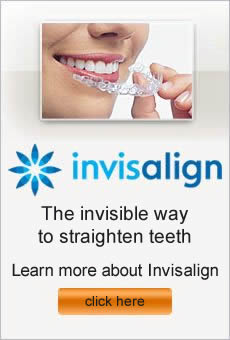When people think about orthodontic treatment, they usually imagine braces. Although braces are a common form of therapy, orthodontists utilize other appliances as well. Depending on the situation, your orthodontist may recommend the following orthodontic devices:
Braces
The most recognizable orthodontic appliances, braces are the brackets or aligners used to shift teeth into the desired position. Traditional braces involve metal brackets and wires, but modern advances have provided other options such as lingual braces, ceramic brackets, and Invisalign clear aligners.
Retainers
Once you complete treatment with braces, your orthodontist will likely fit you for a retainer, which is designed to keep teeth from moving out of alignment. Usually, retainers are worn almost constantly at first and then less frequently for maintenance purposes.
Rapid Palatal Expander (RPE)
Generally used for crowding of upper teeth or on a narrow jaw, the rapid palatal expander (RPE) is placed in the roof of the mouth and turned with a special key to increase the upper jaw area. Expanders are typically in place for about four to six months.
Headgear
When patients have a severe overjet or their teeth need significant repositioning, the orthodontist may recommend head gear. Connected to the upper bands, head gear guides the jaw growth in the right direction.
Thumb Guard
As permanent teeth begin to erupt, thumb sucking can create issues and cause alignment problems. A thumb guard, which is positioned in the roof of the mouth, stops the thumb from pushing up against the front teeth.
Common Orthodontic Appliances at Mehdi Fotovat Sherman Oaks Orthodontist
Affecting one of every 700 babies annually, a cleft palate is a common birth defect that results in facial or oral malformations. With a cleft palate, a split or opening occurs in the roof of the mouth and can impact the hard and/or soft palate. A cleft lip is a split or separation of the two sides of the upper lip. These defects can occur on one or both sides of the mouth. In fact, patients can have a cleft palate without a cleft lip, a cleft lip without a cleft palate, or both a cleft lip and cleft palate.
Most of the causes of a cleft defect are unknown. These issues typically occur very early in pregnancy. A cleft palate or cleft lip develops when not enough tissue is present or the tissue does not join together properly.
Because cleft defects create an obvious physical manifestation, diagnosing these deformities is usually easy. Sometimes, an ultrasound will pick up a cleft palate or cleft lip. If that doesn’t happen, the physical signs are often identified and confirmed at birth.
Cleft palates and cleft lips can cause difficulties such as eating problems, hearing concerns, speech delays, and dental issues. Children with cleft palates or cleft lips often have an increased risk of cavities as well as extra, missing, or malformed teeth. Part of treatment involves addressing oral health concerns.
Treatment for cleft palate issues begins in infancy and can continue into adulthood. Usually, children diagnosed with cleft palate deformities will have a team of doctors and specialists, including:
• A plastic surgeon to address the physical appearance
• An ear, nose, and throat doctor to evaluate and treat hearing issues
• An oral surgeon to reposition the upper jaw as needed and repair a cleft impacting the gum area
• An orthodontist to straighten the bite and teeth
• A dentist for routine dental care
• A speech pathologist to identify speech and feeding problems
• A speech therapist to work on language development
We care about your smile at Mehdi Fotovat Sherman Oaks Orthodontist
Choosing orthodontic treatment for yourself or a loved one is a big decision. Before taking this step, you need to gather detailed information about what this process entails. Getting answers to your questions will help you determine the best treatment and find an orthodontist you can trust to create a flawless smile.
Consider talking about these questions with your orthodontist:
Does having braces hurt?
Many kids, and adults, worry that traditional braces cause pain. While, you may experience some initial discomfort, your mouth will get used to the brackets. Your orthodontist can make recommendations to help during the adjustment period.
How long will treatment last?
Though the answer is often dependent on the severity of the problem and the compliance of the patient, your orthodontist should be able to provide an estimated time frame.
Are there different types of orthodontic treatment?
After evaluating your mouth, your orthodontist will explain the available options. Depending on your age and the issue you want to correct, your doctor may suggest traditional braces, ceramic brackets, or clear aligners for older teen and adults patients.
Do I have to change my diet?
During orthodontic treatment, you need to protect your braces from damage, so stay away from sticky or hard substances. Ask your orthodontist for a list of foods and snacks to avoid.
Will my teeth shift after the braces come off?
Once you complete the active stage of treatment, you will need to wear a retainer to maintain those results. To protect your new smile, the orthodontist will create custom appliances and then review the amount of time you need to wear the retainers.
Orthodontic Treatment at Mehdi Fotovat Sherman Oaks Orthodontist
Although many adults may feel embarrassed by their crooked teeth, the idea of metal braces may seem even worse. Advances in technology have made it possible for orthodontists to offer treatments that will produce gorgeous results without drawing attention to your orthodontic therapy.
Orthodontics is often seen as treatment for kids and teenagers, but it can actually correct bite issues, address crowding, and straighten teeth for patients of any age. You are never too old to reap the benefits of a fabulous smile. Not only will a straight smile look better, but it can also improve your dental health. Crooked, crowded, or gapped teeth can make routine care more difficult, which can increase the chances of developing issues like tooth decay or gum disease.
Before recommending treatment, your orthodontist will likely take X-rays and perform a complete examination. Once the doctor has gathered all the information, he or she will explain your options for treatment. Many adults prefer the following orthodontic therapies:
Ceramic brackets
Similar to traditional wire-and-bracket braces, ceramic brackets are constructed from tooth-colored materials. With ceramic brackets, only the connecting wires are visible, which makes these braces much less noticeable than with metal orthodontia.
Lingual braces
Applied to the back side of teeth, lingual braces aren’t apparent when you smile. These braces take some getting used to and they may cost more than other options, but they provide adults with inconspicuous orthodontic treatment.
Clear aligners
With options such as ClearCorrect or Invisalign, patients can achieve flawless smiles without the hassle and discomfort of traditional metal braces. These systems use clear, custom aligners to gently move teeth into the desired position. Because the aligners are removable, patients can take them out to eat, brush, or for special occasions.
Adult Braces at Mehdi Fotovat Sherman Oaks Orthodontist
Whether participating or cheering from the sidelines, Americans love sports. From baseball to football to basketball, we enjoy the thrill of competition. Participating in sports for recreation is great for your health, but it can be hazardous to your mouth. In fact, 40 percent of all sports injuries involve the face.
To keep your smile in tact, most dentists and orthodontists recommend wearing a mouth guard in contact sports like hockey, football, or soccer. As well, they also suggest using this type of dental appliance in non-contact activities such as skateboarding and bicycling. Mouth guards help cushion your teeth, gums, and jaws from common injuries sustained during sports activities.
Designed to cover your teeth, mouth guards come in different varieties, including:
• Ready-made
The least expensive option, ready-made mouth guards are also less comfortable and less effective than the other types of protection. You can find ready-made mouth guards at most sporting goods stores.
• Mouth-formed
Generally created from acrylic or thermoplastic materials, mouth-formed guards will shape to fit your mouth are being placed in boiling water. These mouth guards don’t offer the same level of support as custom-made appliances.
• Custom
This is the best option, as custom mouth guards are constructed to precisely fit your mouth. Your orthodontist will take a mold of your teeth that a dental lab will use to produce your custom mouth guard.
Once you purchase a mouth guard, make sure to take good care of your oral appliance. Clean and rinse the guard after each use; then, allow it to air dry. Remember to check the appliance before you play to ensure it is still in good condition.
Mouthguards at Mehdi Fotovat Sherman Oaks, CA Orthodontist



